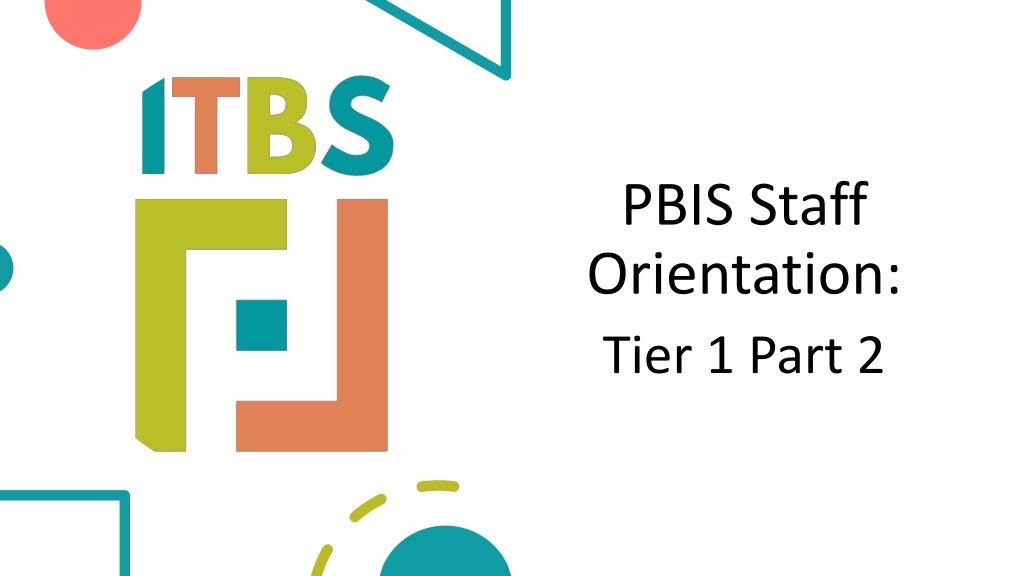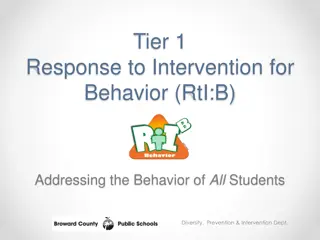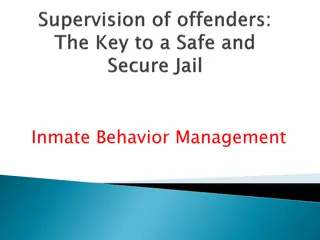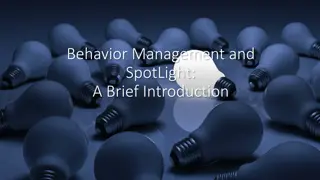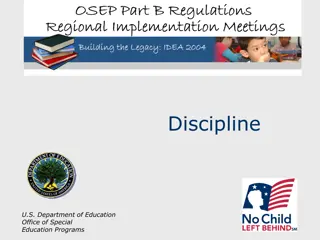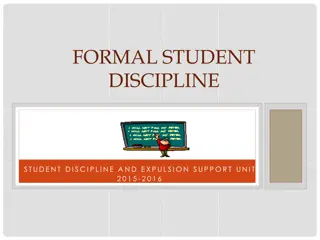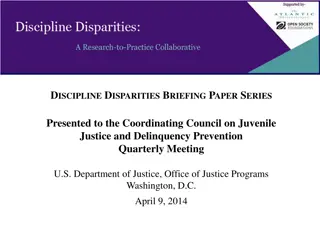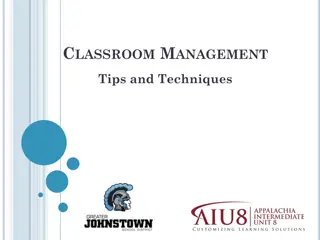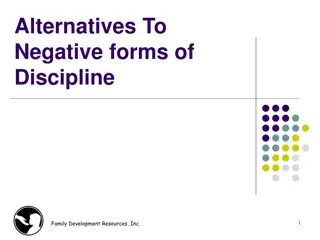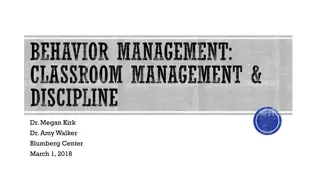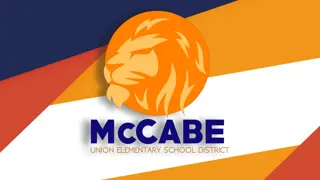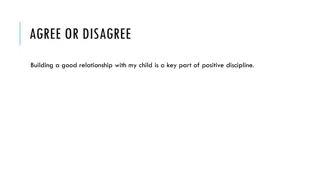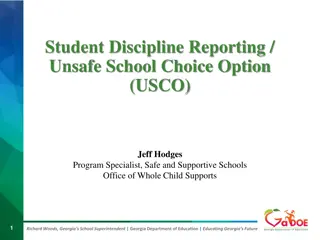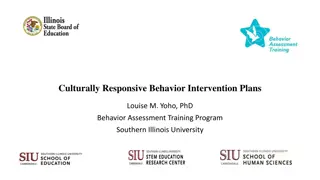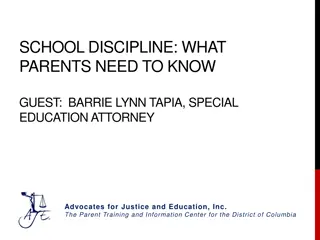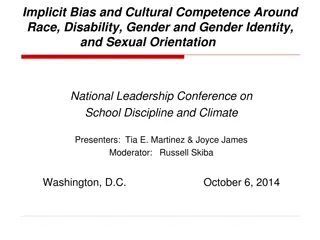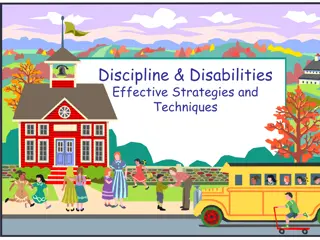Effective Discipline Practices and Behavior Management in Schools
Explore the principles of effective discipline practices and behavior management in schools. Learn about preventing, teaching, and responding to behaviors, addressing environmental factors, offering support and accommodations, and understanding why behaviors occur. Discover the negative impacts of ineffective discipline strategies like exclusionary measures and zero-tolerance policies, and examine alternative approaches to creating a positive and supportive school environment.
Download Presentation

Please find below an Image/Link to download the presentation.
The content on the website is provided AS IS for your information and personal use only. It may not be sold, licensed, or shared on other websites without obtaining consent from the author. Download presentation by click this link. If you encounter any issues during the download, it is possible that the publisher has removed the file from their server.
E N D
Presentation Transcript
PBIS Staff Orientation: Tier 1 Part 2
Todays Agenda Effective Discipline Practices What Is Behavior And Why It s Happening Schoolwide Response To Behavior Wrap Up Reflect and Discuss
Our Tier 1 Team [Introduce your school s Tier 1 Team here]
[List your training expectations here] Training Expectations
Remembering Our Why [Remind staff of the why that was established and shared in part 1]
Effective Discipline Practices
There is one burden that consumes more time, energy, and attention than any other school discipline -Chard, Smith, and Sugai (1992)
Ineffective Discipline The problem with exclusionary discipline Out of school suspension and zero-tolerance approaches to discipline do not reduce misbehavior and correlate with lower achievement (Irvin et al. 2004; Skiba & Rausch, 2006) Students who are suspended are more likely to be held back or drop out of school (Balfanz & Boccanfuso, 2007) Higher levels of exclusionary discipline within schools over time generate collateral damage, negatively affecting the academic achievement of non-suspended students (Perry & Morris, 2014)
A Different Approach Effective Discipline PREVENT TEACH RESPOND
Consider & Address Environmental Factors Supports and accommodations Predictability Motivation Effective Instruction Consistent Consequences Acknowledge Prompt / Reteach Correct
What is Behavior & Why it s Happening
Is the Behavior Really a Problem ? Does the behavior interfere with learning? Is it harmful to self or others? Does it put the student at risk for social challenges?
Remember Behavior Is learned Is purposeful Continues because it is effective (reinforced) Appropriate behavior must Be taught Serve a purpose Be effective (reinforced)
Know Your ABCs Antecedent What happens immediately before the problem behavior- also referred to as the trigger. Behavior The actions of the student immediately following the antecedent/trigger. Consequence Immediate changes in the environment in response to the student s behavior, including actions of others.
History & Setting Events Trauma Living environment Caregiver(s), friends, support system Values Goals shirt & long term Motivation
Functions of Behavior BEHAVIOR Sensory Escape Attention Tangible Gain Input Item/ Activity Escape Input Activity/ Setting Person Adult Peer Food
Sensory The student is engaging in the behavior to gain or escape some type of sensory input. Examples
Escape The student is engaging in the behavior to escape or avoid something in the environment. Examples
Attention The student is engaging in the behavior to get attention (good or bad) from another person (adult or peer). Examples
Tangible The student is engaging in the behavior to gain access to a tangible item such as food, a toy, an activity, or a privilege. Examples
Selective Attention Test Activity How does this video apply to the behavior problem-solving process?
Schoolwide Response To Behavior
Respond To Behavior In Predictable Ways When should a student be sent to the office? When does a behavior warrant an Office Discipline Referral? How can teachers and staff respond to behavior in similar ways across settings?
Defining Behavior How To: How Not To: Active Measurable Observable Un-observable Emotional States Internal Processes
[Insert a screen shot of your school s list of behavior definitions here] Behavior Definitions
[Insert a screen shot of your school s behavior flowchart here] Schoolwide Behavior Must Be Leveled
Minor Behavior Classroom-Managed Behavior [list the minor behaviors identified for your school]
What Do We Do When Minor Behavior Occurs? Continuum of response strategies for contextually inappropriate behavior Planned ignoring Physical proximity Direct eye- contact Signal/ nonverbal cue Support for procedures & routine Acknowledge others behavior Re-teach Redirect Specific and contingent error correction Conference with student Shaping Provide choice
What If The Minor Behavior Continues? Minor behavior tracking [List your school s process for tracking minor behavior] Criteria for when a minor becomes a major [List your school s criteria for when a minor becomes a major]
Major Behavior Office-Managed Behavior [list the major behaviors identified for your school]
Office Discipline Referrals (ODRs) Data collection tool that assists in the documentation of problem behavior ODRS are not the consequence, that are simply a tool for collecting information Teacher responds according to behavior flowchart Teacher completes office discipline referral Staff observes Problem/ incident
[Insert a screen shot of your ODR here] [List your school s process specific to ODRs how are they completed, who enters, where to put completed form, other documentation needed] ODR Process
[Describe your teams process for using data to make decisions (e.g., how often will data be reviewed, what will you be looking for, how often will schoolwide data be shared with teachers/staff)] Data-Based Decision- Making
What are your biggest takeaways from today? What were the surprises? What are you most excited about? Any remaining concerns? Reflect & Discuss
Thank You! Any questions?
